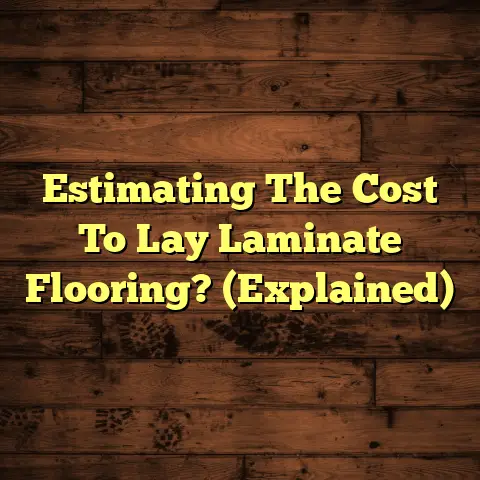Carpet Tiles Outdoors: A Bad Idea? (3 Mistakes)
We all dream of creating beautiful outdoor spaces, right?
A cozy patio, a welcoming walkway, a stylish deck.
But let’s be real, outdoor flooring takes a beating.
Sun, rain, snow, and foot traffic – it’s a constant battle against the elements.
That’s why traditional materials like wood, stone, and concrete are so popular.
They’re tough, durable, and can handle whatever Mother Nature throws their way.
Now, carpet tiles…they’re a whole different ballgame.
I get the appeal.
They’re affordable, easy to install, and come in tons of colors and patterns.
Plus, they can add a touch of softness and warmth to an outdoor space.
But here’s the million-dollar question: Are carpet tiles really suitable for outdoor use?
Or are you just setting yourself up for a world of headaches?
In my experience, the answer is often the latter.
Using carpet tiles outdoors can be a recipe for disaster if you’re not careful.
And that’s what I want to talk about today.
I want to help you avoid the common pitfalls and mistakes that I’ve seen homeowners make time and time again.
So, buckle up, grab a cup of coffee, and let’s dive into the three critical mistakes you need to avoid when considering carpet tiles for your outdoor spaces.
Trust me, your wallet (and your sanity) will thank you.
Mistake #1: Underestimating Environmental Factors
Okay, let’s get down to brass tacks.
The first, and arguably biggest, mistake people make is underestimating just how brutal the outdoor environment can be.
I mean, think about it.
Your flooring is constantly exposed to the elements, day in and day out.
It’s not like your living room, where the temperature is controlled and the sun is filtered through the windows.
Outdoors, it’s a free-for-all.
Weather Resistance: Can Your Carpet Tiles Handle the Heat (and the Cold, and the Rain)?
Let’s start with weather resistance.
Rain, snow, UV rays, humidity, temperature swings – it’s a constant barrage.
Now, most carpet tiles are designed for indoor use.
They’re made to withstand foot traffic, spills, and maybe the occasional pet accident.
But they’re not built to handle the extremes of the outdoors.
I’ve seen carpet tiles fade, warp, and even disintegrate after just a few months of exposure to the elements.
The sun’s UV rays can break down the fibers, causing them to become brittle and fade.
Rain and snow can soak into the tiles, leading to mold and mildew growth.
And temperature fluctuations can cause the tiles to expand and contract, which can lead to cracking and warping.
According to the Carpet and Rug Institute (CRI), proper maintenance and protection from excessive moisture and sunlight are crucial for extending the life of any carpet, but outdoor exposure intensifies these challenges significantly.
Think about this: I once had a client who installed carpet tiles on their patio.
They loved the look at first.
But after just one summer, the tiles were completely faded and starting to fall apart.
They had to rip them all up and start over with a more durable material.
It was a costly and time-consuming mistake that could have been avoided with a little research.
Material Composition: What Are Your Carpet Tiles Made Of?
The material composition of your carpet tiles is another critical factor to consider.
Most carpet tiles are made from synthetic fibers like nylon, polypropylene, or polyester.
These materials are generally durable and stain-resistant, but they’re not all created equal when it comes to outdoor performance.
Nylon is one of the most durable synthetic fibers, but it’s also the most expensive.
It’s a good choice for high-traffic areas, but it can still fade and degrade over time with prolonged exposure to UV rays.
Polypropylene is a less expensive option that’s more resistant to moisture and mildew.
However, it’s not as durable as nylon and can crush easily under heavy foot traffic.
Polyester is another affordable option that’s relatively resistant to fading.
But it’s not as durable as nylon or polypropylene and can stain easily.
And let’s not forget about the backing of the carpet tiles.
Many carpet tiles have a latex or PVC backing, which can break down over time when exposed to moisture and temperature fluctuations.
This can cause the tiles to become loose and start to peel up.
Mold and mildew are major concerns with outdoor carpet tiles.
According to the EPA, mold thrives in moist, humid environments, and carpet tiles provide the perfect breeding ground.
Once mold takes hold, it can be difficult to get rid of and can pose a health hazard.
I’ve seen countless outdoor carpet tile installations ruined by mold and mildew.
It’s not a pretty sight, and it’s definitely not something you want to deal with.
Installation Issues: Are You Setting Yourself Up for Failure?
Even if you choose the right carpet tiles for outdoor use, improper installation can still lead to problems.
One of the most common mistakes I see is inadequate sealing.
When you install carpet tiles outdoors, it’s crucial to seal the edges and seams to prevent moisture from seeping underneath.
If water gets trapped under the tiles, it can lead to mold and mildew growth, as well as adhesive failure.
Another common mistake is improper surface preparation.
Before you install carpet tiles, you need to make sure the surface is clean, dry, and level.
If the surface is uneven, the tiles won’t adhere properly and can start to peel up.
And if the surface is dirty or damp, the adhesive won’t bond properly, which can also lead to problems.
I always recommend using a high-quality outdoor adhesive that’s specifically designed for carpet tiles.
Don’t skimp on the adhesive – it’s the glue that holds everything together.
And make sure to follow the manufacturer’s instructions carefully.
I remember one job where the homeowner tried to save money by using a cheap, indoor adhesive.
Within a few weeks, the carpet tiles started to come loose.
They had to rip everything up and start over with the right adhesive.
It was a costly mistake that could have been avoided with a little foresight.
Mistake #2: Ignoring Maintenance Requirements
Alright, let’s talk about maintenance.
I know, it’s not the most exciting topic, but it’s crucial if you want your outdoor carpet tiles to last.
A lot of homeowners think that once they install carpet tiles, they can just sit back and enjoy their new outdoor space.
But that’s not the case.
Outdoor carpet tiles require regular maintenance to keep them looking their best and to prevent problems like mold, mildew, and fading.
Cleaning Challenges: Dirt, Debris, and Moisture – Oh My!
One of the biggest challenges with outdoor carpet tiles is keeping them clean.
They’re constantly exposed to dirt, debris, leaves, pollen, and other outdoor gunk.
And when it rains, all that stuff gets washed into the fibers, making them look dingy and stained.
Regular vacuuming is essential to remove loose dirt and debris.
I recommend vacuuming your outdoor carpet tiles at least once a week, or more often if you have pets or live in a dusty area.
You’ll also need to clean your carpet tiles regularly to remove stains and grime.
I recommend using a mild soap and water solution and a soft-bristled brush.
Avoid using harsh chemicals or abrasive cleaners, as these can damage the fibers.
For tough stains, you may need to use a specialized carpet cleaner.
But be sure to test it in an inconspicuous area first to make sure it doesn’t damage the tiles.
And don’t forget about mold and mildew.
If you live in a humid area, you’ll need to take extra precautions to prevent mold and mildew growth.
I recommend using a mildew-resistant cleaner and making sure to dry the tiles thoroughly after cleaning.
According to a study by the American Society for Testing and Materials (ASTM), regular cleaning can significantly extend the life of outdoor carpet tiles and prevent the growth of mold and mildew.
Longevity and Replacement Frequency: Are You Prepared for the Long Haul?
Let’s be honest, outdoor carpet tiles aren’t going to last forever.
Even with regular maintenance, they’ll eventually start to show their age.
The lifespan of outdoor carpet tiles depends on a number of factors, including the quality of the tiles, the amount of foot traffic, and the severity of the weather conditions.
But in general, you can expect outdoor carpet tiles to last anywhere from 1 to 5 years.
That’s significantly less than more traditional outdoor flooring options like wood, stone, or concrete, which can last for decades with proper care.
And that means you’ll need to replace your carpet tiles more frequently, which can add up to a significant cost over time.
I always tell my clients to factor in the cost of replacement when considering outdoor carpet tiles.
Don’t just focus on the initial cost of the tiles.
Think about how often you’ll need to replace them and how much that will cost you in the long run.
Incompatibility with Outdoor Furnishings: Are Your Chairs Ruining Your Carpet?
Outdoor furniture can also take a toll on carpet tiles.
Heavy furniture can crush the fibers, leaving unsightly indentations.
And sharp furniture legs can snag and tear the tiles.
I recommend using furniture pads under the legs of your outdoor furniture to protect the carpet tiles.
This will help to distribute the weight more evenly and prevent damage.
You should also avoid dragging furniture across the carpet tiles, as this can cause the fibers to become frayed and worn.
And let’s not forget about foot traffic.
High-traffic areas, like walkways and entrances, will wear down more quickly than other areas.
I recommend rotating your carpet tiles periodically to distribute the wear more evenly.
This will help to extend the life of your carpet tiles and keep them looking their best.
Mistake #3: Misjudging Suitability for Specific Outdoor Areas
Okay, we’ve covered the environmental factors and the maintenance requirements.
Now, let’s talk about the specific outdoor areas where carpet tiles are (and aren’t) a good fit.
Not all outdoor spaces are created equal.
And some areas are simply not suitable for carpet tiles, no matter how careful you are.
High-Traffic Areas: Are Your Carpet Tiles Ready for a Workout?
High-traffic areas, like patios, walkways, and pool decks, take a beating.
They’re constantly subjected to foot traffic, spills, and other wear and tear.
And carpet tiles, especially those designed for indoor use, may not be able to handle the abuse.
I’ve seen carpet tiles in high-traffic areas wear down in a matter of months.
The fibers become crushed and matted, and the tiles start to look dingy and worn.
If you’re considering carpet tiles for a high-traffic area, I recommend choosing a durable, outdoor-rated tile that’s specifically designed to withstand heavy use.
Look for tiles with a high pile density and a strong backing.
And be prepared to replace them more frequently than you would in a low-traffic area.
Moisture-Prone Locations: A Recipe for Mold and Mildew
Moisture is the enemy of carpet tiles.
And areas that are prone to moisture, like around gardens, near sprinklers, or in shaded regions that retain water, are simply not suitable for carpet tiles.
Moisture can seep into the tiles, leading to mold and mildew growth.
And once mold and mildew take hold, it can be difficult to get rid of.
I’ve seen countless outdoor carpet tile installations ruined by moisture.
The tiles become stained and discolored, and the air can become thick with the smell of mold.
If you live in a humid area or have areas in your yard that are prone to moisture, I recommend avoiding carpet tiles altogether.
Choose a more moisture-resistant flooring option, like stone, concrete, or composite decking.
Aesthetic vs. Practicality: Beauty Isn’t Everything
Finally, let’s talk about aesthetics versus practicality.
I get it.
Carpet tiles can add a touch of style and warmth to an outdoor space.
They come in a wide variety of colors, patterns, and textures, so you can create a look that’s all your own.
But before you get carried away with the aesthetics, it’s important to consider the practical realities.
Carpet tiles may look great at first, but they may not hold up well over time.
They can fade, stain, and wear down quickly, especially in high-traffic areas or areas that are exposed to a lot of moisture.
And if you’re not prepared to maintain them properly, they can quickly become an eyesore.
I always tell my clients to weigh the aesthetics against the practicality.
Don’t just choose carpet tiles because they look good.
Choose them because they’re the right choice for your specific outdoor space and your lifestyle.
Conclusion
So, there you have it – the three critical mistakes you need to avoid when considering carpet tiles for your outdoor spaces.
To recap, those are:
- Underestimating Environmental Factors
- Ignoring Maintenance Requirements
- Misjudging Suitability for Specific Outdoor Areas
I hope this article has been helpful.
I know that choosing the right flooring for your outdoor spaces can be a daunting task.
But with a little research and planning, you can make the right choice for your needs and budget.
Remember, wear-and-tear is a fact of life when it comes to outdoor flooring.
But by making informed decisions and taking proper care of your flooring, you can minimize the impact of the elements and enjoy your outdoor spaces for years to come.
So, before you rush out and buy a bunch of carpet tiles, take a step back and think critically about your needs and your environment.
Are carpet tiles really the best choice for your outdoor space?
Or are you better off with a more durable and weather-resistant material?
The answer may surprise you.
And remember, I’m always here to help.
If you have any questions or need advice on choosing the right flooring for your outdoor spaces, don’t hesitate to reach out.
Happy flooring!





